The forearm bones are surrounded by numerous small muscles that help to flex, extend, adduct, abduct, and rotate your lower arms. So if you really want to develop those solid rock climbing forearms that so many professional climbers seem to have, then you need to perform direct training.
The trick is to perform enough climbing forearm exercises to develop strength, but not so many that you overtrain and impede your performance and gripping ability.
Related sports post: forearm workouts for baseball
Top 5 climbing forearm exercises
Do these 5 exercises if you want those muscular climber forearms that all the pros have. Some drills work on strength, while others prioritize your endurance to give you all-around great gripping ability.
1. Hand gripper
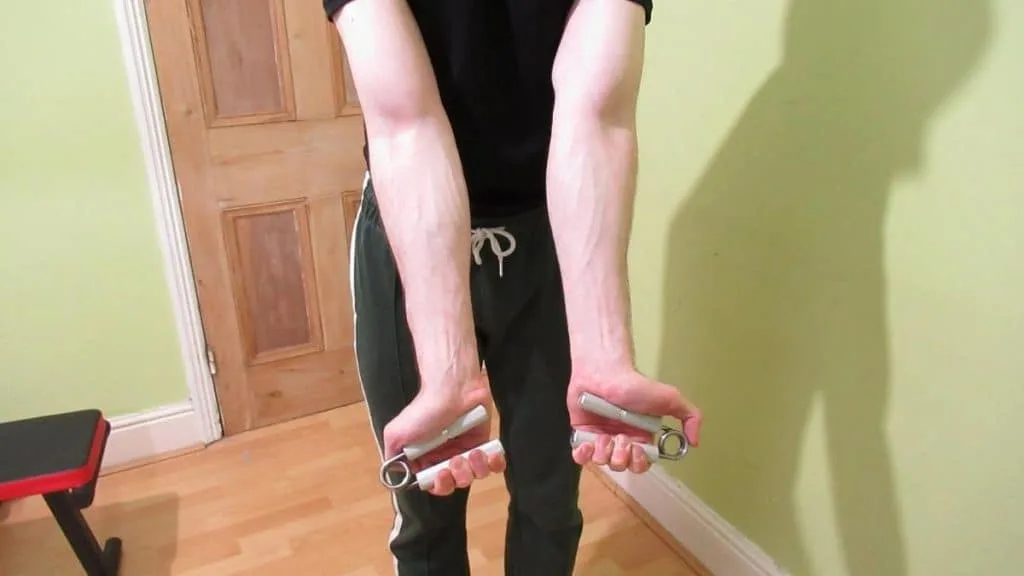
Hand grippers are used by athletes and fitness enthusiasts of all varieties to improve their grip strength. Yet, these handheld tools are especially useful for getting those rock climber forearms because they really work the meat of the muscle, known as the forearm flexors.
Start by holding the device between your fingers and the base of your hand. Begin the rep by pushing your fingers towards your hand until the two ends of the gripper are almost touching. Hold the contraction for a second, and then slowly release the grippers so that your muscles take most of the strain.
If you can’t get to a regular gym, then this drill is particularly useful because you can literally perform it anywhere if you have a spare 5 minutes.
2. Dead hangs

Pull-up bar hangs improve your overall forearm endurance. So in this respect, it’s a must–do exercise for climbing if there ever was one.
When you’re performing this movement. Make sure that you don’t shrug your shoulders all the way up, as this can put unnecessary strain on your rotator cuffs. Instead, keep your back slightly engaged throughout the entire duration of the hang so that your deltoids don’t slip into a compromising position.
To do this exercise properly, grab onto a pull-up bar with an overhand grip. Aim to hold onto the bar with the palms of your hands for as long as possible (60 seconds or more is pretty good).
Eventually, you’ll feel your grip start to give out, and so your fingers will naturally move in to take the strain. This is perfectly normal as you begin to fatigue. Just make sure that you’re gripping with your palms at the beginning of the exercise to really work the bulk of your forearms.
3. Wrist curl
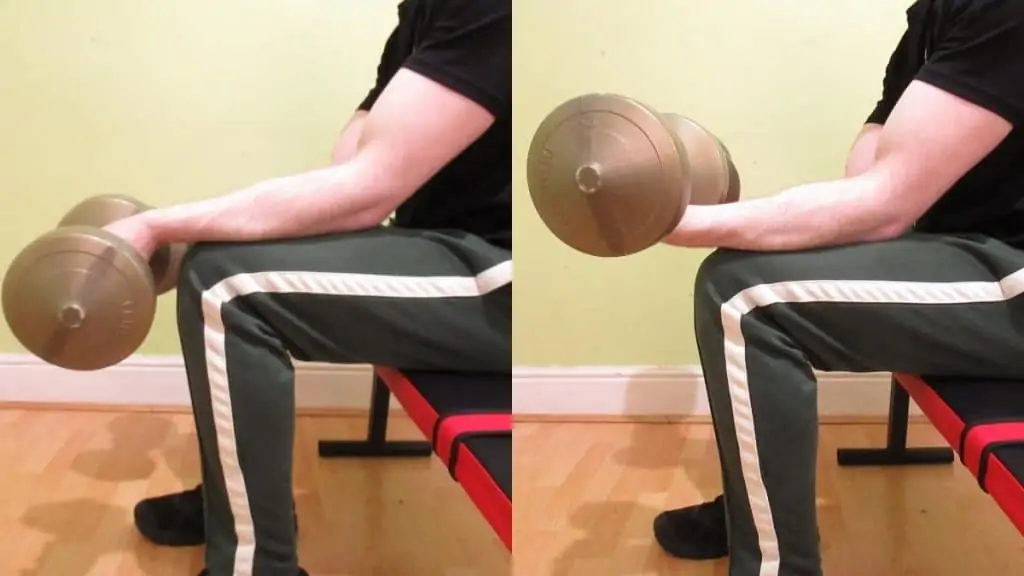
This dynamic training drill works the forearm flexors, the most active lower arm muscle during rock climbing. While I recommend using a bench for this exercise, you can also do it at home over a desk or table, as long as you have access to a dumbbell.
Hold a dumbbell in the palm of one hand and then kneel next to a weight bench. Rest the top of your forearm on the bench and let your hand hang off the edge. Lower the weight towards the floor by bending your wrist and keep going until you feel a nice forearm stretch. Bring the weight back up by flexing your wrist and squeezing your forearm at the top of the rep.
Repeat for 2-4 sets of 10-12 reps. Always control the weight so that your forearms—not your connective tissue—take the strain.
4. Reverse wrist curl

If you truly want those muscular rock climber forearms, then you need to do some kind of reverse wrist curl to work the muscles in the posterior compartment (top) of your lower arm.
Many climbers have decent flexors. But the elite athletes have strong extensors, too, because they realize the importance of having balanced forearms that are capable of withstanding fatigue and supporting their body weight.
Like the regular wrist curl, hold a dumbbell in your hand and then kneel at the side of a bench. This time, however, you’re going to hold the dumbbell with a pronated (palms down) grip and rest the underside of your forearm on the bench.
Next, lower the weight towards the ground until you feel a deep yet comfortable stretch in the top of your forearm. Then, curl the weight back up by extending your wrist towards the ceiling. Aim to raise your hand above your forearm as you lift the weight up to really contract your extensors.
Repeat for 2-4 sets of 12-20 reps. The extensors are slow-twitch, and as endurance muscles that are used in climbing, they respond best to high reps.
5. Plate pinches
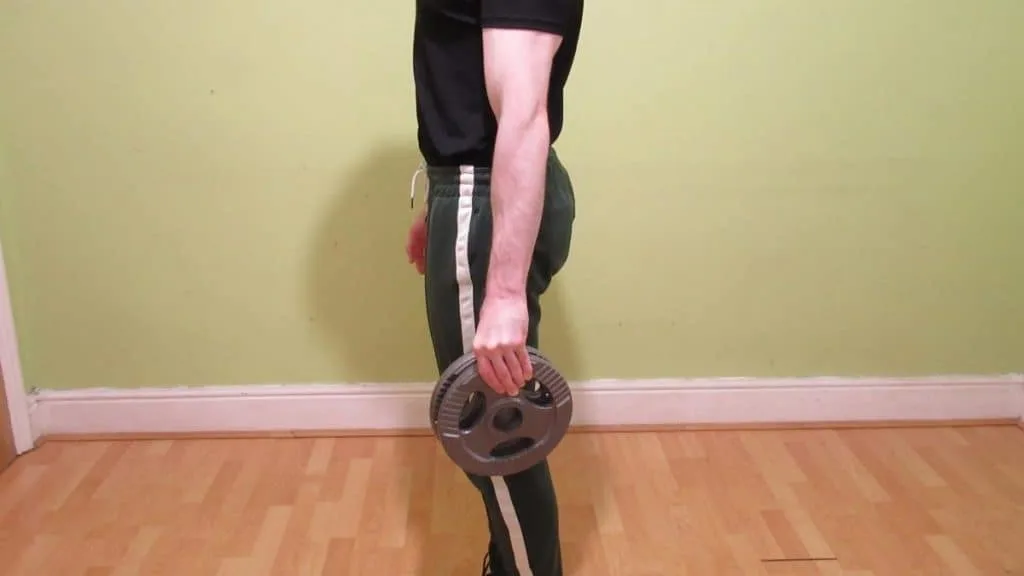
Many climbers naturally train their grip with pull-up bar hangs, farmer’s walks (another great exercise), and hand grip squeezes. Yet, few enthusiasts work on their pinching strength, and this is a mistake because being able to pinch weights strengthens your fingers, whereas traditional weight lifting exercises generally do not.
Pinch a light weight plate between your thumb and fingers and hold it for 30 seconds. To get the weight disc into position, place it on its rim with one hand and then grab it with the other.
Once you can do 2-3 sets of 30-second holds with each hand, it’s time to increase the resistance.
Is doing forearm training for climbing useful?
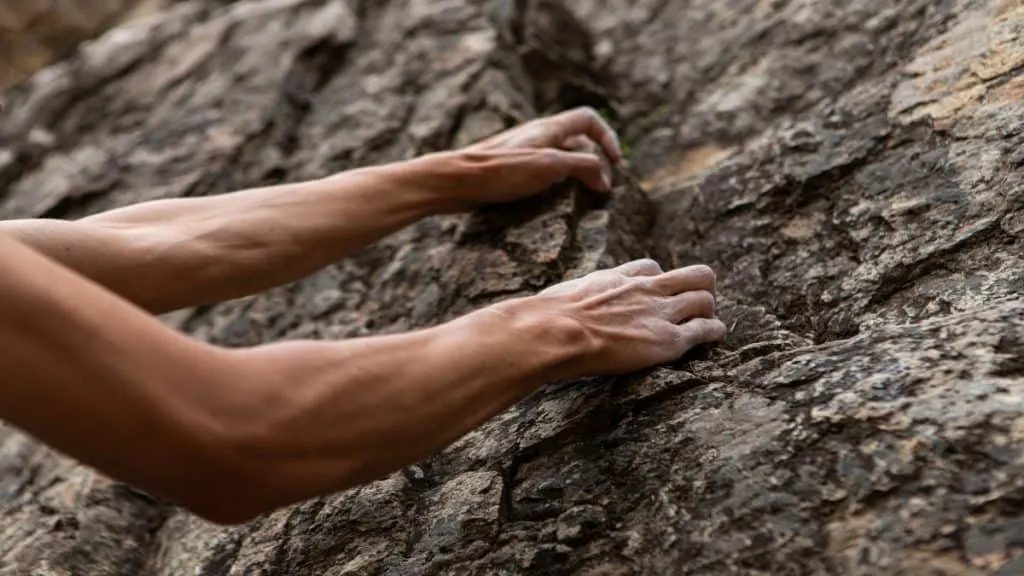
Forearm training for climbing is very beneficial because it lets you work the smaller lower arm muscles like the wrist extensors, which usually only get trained isometrically during actual climbs.
Moreover, by increasing your forearm endurance and work capacity, your lower arms are less likely to give out prematurely, which will make you a better climber.
If you’re relativity new to climbing, strengthening these critical gripping muscles will also help you improve your skill level at a faster rate because you’ll be able to focus more on improving your climbing technique rather than worrying about how (or if) your muscles are going to hang on.
How can you get tough rock climbing forearms?

If you really want those formidable rock climbing forearms, then direct resistance training is the best and fastest route to take. [1] Do some kind of reverse wrist curl for the extensors and regular forearm curls for the flexors.
Also, don’t neglect your grip because these grip training drills build great forearms, much like climbing itself.
See also: tennis forearm training
Which climbing forearm stretches should you perform?
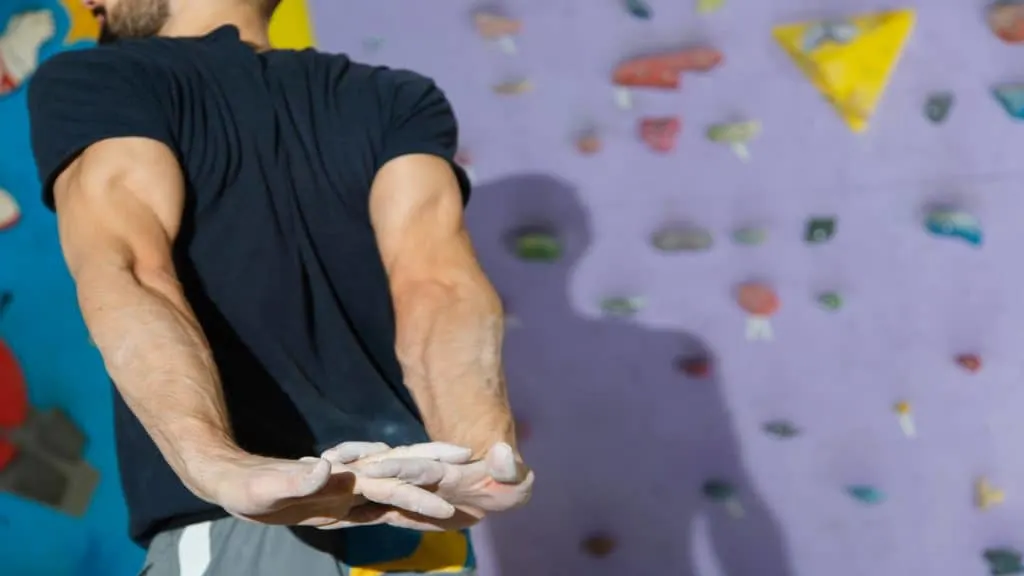
Integrating climbing forearm stretches into a warm up can help to loosen up your muscles. Some exercise science experts, however, say that stretching can acutely reduce your performance.
So perhaps consider doing stretches after a workout or at work, wherever you have a spare 5 minutes.
Here’s a good one: Extend one arm out in front of you and fully lock your elbow out. Then, raise up your hand as if you’re about to wave to a friend. Next, take your other hand and gently pull the fingers of your “working hand” towards you. You should feel a stretch in the bottom of your forearm. Hold it for 15-30 seconds, and then move onto the opposite arm.
To stretch the extensors, do the opposite motion. Bend your wrist down so that your palm is facing toward you, elbow again completely locked out. Then, with your other hand, gently pull your fingers towards your body. Aim to hold the stretch for 15-30 seconds.
How can you treat forearm pain from climbing?

If you’re experiencing climbing forearm pain, then first and foremost, make sure to stop doing any activity that makes you feel the pain. [2] From there, it’s best to talk to your doctor so that you can get a personalized treatment plan.
Rest, Ice, Compression, and Elevation (RICE) is a common way to begin the healing process for sporting injuries. Simply start by resting the affected area and then applying ice to it to reduce any swelling that may have built up.
From there, apply a light medical bandage around your forearm near the top of your elbows to promote blood flow to the damaged tissue.
Also, try to keep your forearm elevated. Like icing, this can reduce pain and swelling.
Taking nonsteroidal anti-inflammatory drugs, commonly known as NSAIDs, is also a common method for reducing pain that arises from climbing or other sports.
After the pain has died down, rehabilitation is often the next phase. During rehab, you’ll do light exercises like a rice bucket workout for climbing to build up functional strength.
Remember, always consult with a doctor and physical therapist to treat any pain that you have. Also, consider doing active recovery to minimize future injuries. [3]
Read more: arm wrestling forearm training
Conclusion: Creating an epic climbing forearm workout
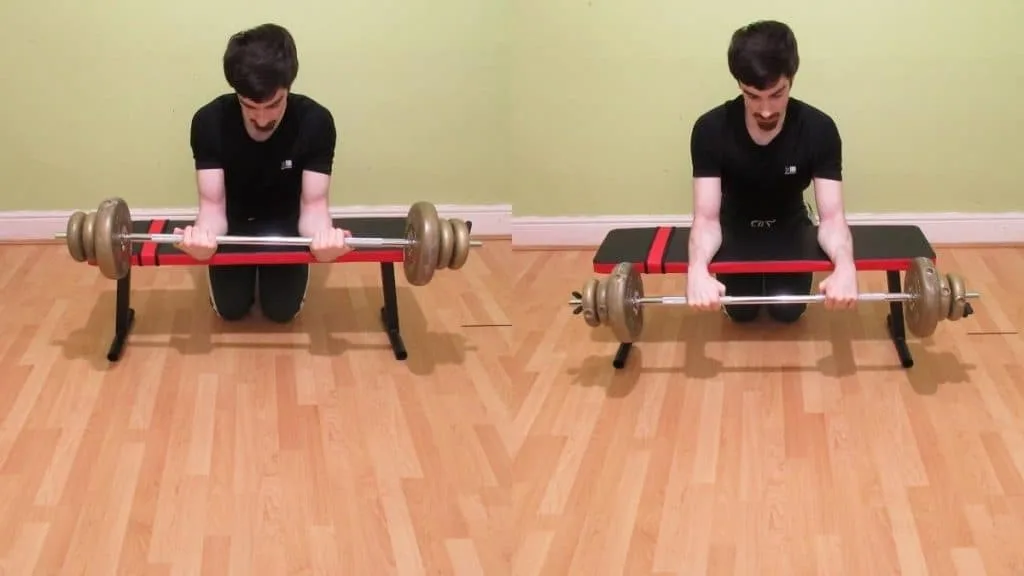
There are many different exercises and workouts that you can do to get those “rock-solid” climber forearms. I particularly like doing wrist curls for overall strength and also mixing in some endurance work with either pull-up bar hangs or farmer’s carries since you need both raw power and a long-lasting work capacity to excel in rock climbing. [4]
This way, you’re building those strong rock climbing forearms that help to support your body mass. But you’re also improving your endurance and work capacity so that you can maintain peak performance for longer.
References
- Fryer, S., Stone, K. J., Sveen, J., Dickson, T., España-Romero, V., Giles, D., Baláš, J., Stoner, L., & Draper, N. (2017). Differences in forearm strength, endurance, and hemodynamic kinetics between male boulderers and lead rock climbers. European Journal of Sport Science, 17(9), 1177–1183. https://doi.org/10.1080/17461391.2017.1353135
- Holtzhausen, L.-M., & Noakes, T. D. (1996). Elbow, Forearm, Wrist, and Hand Injuries Among Sport Rock Climbers. Clinical Journal of Sport Medicine, 6(3), 196–203. https://doi.org/10.1097/00042752-199607000-00010
- HEYMAN, E. L. S. A., DE GEUS, B. A. S., MERTENS, I. N. G. E., & MEEUSEN, R. O. M. A. I. N. (2009). Effects of Four Recovery Methods on Repeated Maximal Rock Climbing Performance. Medicine & Science in Sports & Exercise, 41(6), 1303–1310. https://doi.org/10.1249/mss.0b013e318195107d
- Fryer, S., Stoner, L., Stone, K., Giles, D., Sveen, J., Garrido, I., & España-Romero, V. (2016). Forearm muscle oxidative capacity index predicts sport rock-climbing performance. European Journal of Applied Physiology, 116(8), 1479–1484. https://doi.org/10.1007/s00421-016-3403-1

